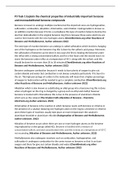Other
Unit 14 Applications of organic chemistry Assignment 2
- Institution
- PEARSON (PEARSON)
Received triple D*s in my applied science extended diploma all my assignments have been completed to the highest standard possible having been checked by several teachers ensuring the correct grade was given to me each of my assignments are plagiarism free and each assignment I've completed I've me...
[Show more]



